Blog & Latest Updates
Fly Fishing Articles
Insects by Common Name


> > Mongaup Creek
Closeup insects from Mongaup Creek
Neoleptophlebia Mayfly Nymph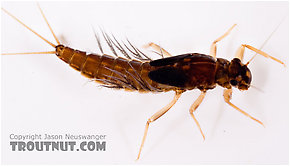 View 6 Pictures
View 6 Pictures
 View 6 Pictures
View 6 PicturesCollected May 6, 2007 from Mongaup Creek in New York
Added to Troutnut.com by Troutnut on May 18, 2007
Added to Troutnut.com by Troutnut on May 18, 2007
Female Baetis (Blue-Winged Olives) Mayfly Spinner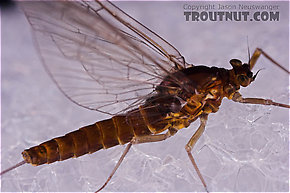 View 4 PicturesI captured and photographed this specimen as a dun before she molted into the spinner photographed here. Her wings got a bit torn up in the process.
View 4 PicturesI captured and photographed this specimen as a dun before she molted into the spinner photographed here. Her wings got a bit torn up in the process.
 View 4 PicturesI captured and photographed this specimen as a dun before she molted into the spinner photographed here. Her wings got a bit torn up in the process.
View 4 PicturesI captured and photographed this specimen as a dun before she molted into the spinner photographed here. Her wings got a bit torn up in the process.Collected April 19, 2006 from Mongaup Creek in New York
Added to Troutnut.com by Troutnut on April 21, 2006
Added to Troutnut.com by Troutnut on April 21, 2006
Epeorus pleuralis (Quill Gordon) Mayfly Nymph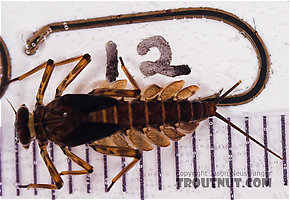 View 4 PicturesThis Epeorus pluralis dun is recently deceased in these photos. I decided not to photograph several lively, less mature nymphs. This one was ready to hatch, as indicated by the black wing pads (
View 4 PicturesThis Epeorus pluralis dun is recently deceased in these photos. I decided not to photograph several lively, less mature nymphs. This one was ready to hatch, as indicated by the black wing pads (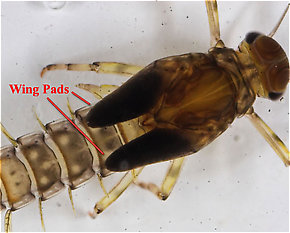 Wing pad: A protrusion from the thorax of an insect nymph which holds the developing wings. Black wing pads usually indicate that the nymph is nearly ready to emerge into an adult.). I believe it had not been dead long enough to lose its natural coloration.
Wing pad: A protrusion from the thorax of an insect nymph which holds the developing wings. Black wing pads usually indicate that the nymph is nearly ready to emerge into an adult.). I believe it had not been dead long enough to lose its natural coloration.
 View 4 PicturesThis Epeorus pluralis dun is recently deceased in these photos. I decided not to photograph several lively, less mature nymphs. This one was ready to hatch, as indicated by the black wing pads (
View 4 PicturesThis Epeorus pluralis dun is recently deceased in these photos. I decided not to photograph several lively, less mature nymphs. This one was ready to hatch, as indicated by the black wing pads (
The wing pads on this final instar Baetidae mayfly nymph are extremely dark.
Collected April 19, 2006 from Mongaup Creek in New York
Added to Troutnut.com by Troutnut on April 21, 2006
Added to Troutnut.com by Troutnut on April 21, 2006
Ephemerella aurivillii Mayfly Nymph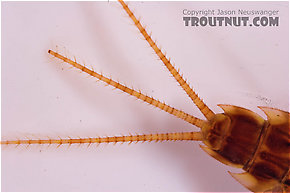 View 4 PicturesThis specimen was collected together with a darker one of the same species.
View 4 PicturesThis specimen was collected together with a darker one of the same species.
 View 4 PicturesThis specimen was collected together with a darker one of the same species.
View 4 PicturesThis specimen was collected together with a darker one of the same species.Collected April 19, 2006 from Mongaup Creek in New York
Added to Troutnut.com by Troutnut on April 21, 2006
Added to Troutnut.com by Troutnut on April 21, 2006
Cinygmula subaequalis (Small Gordon Quill) Mayfly Nymph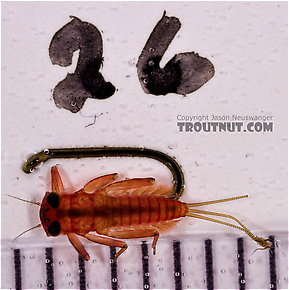 View 3 PicturesI had heard reports of a bright red heptageniid nymph before but never seen one until I found this early instar (Instar: Many invertebrates molt through dozens of progressively larger and better-developed stages as they grow. Each of these stages is known as an instar. Hard-bodied nymphs typically molt through more instars than soft-bodied larvae.) specimen in a very high water quality small stream in the Catskills.
View 3 PicturesI had heard reports of a bright red heptageniid nymph before but never seen one until I found this early instar (Instar: Many invertebrates molt through dozens of progressively larger and better-developed stages as they grow. Each of these stages is known as an instar. Hard-bodied nymphs typically molt through more instars than soft-bodied larvae.) specimen in a very high water quality small stream in the Catskills.
 View 3 PicturesI had heard reports of a bright red heptageniid nymph before but never seen one until I found this early instar (Instar: Many invertebrates molt through dozens of progressively larger and better-developed stages as they grow. Each of these stages is known as an instar. Hard-bodied nymphs typically molt through more instars than soft-bodied larvae.) specimen in a very high water quality small stream in the Catskills.
View 3 PicturesI had heard reports of a bright red heptageniid nymph before but never seen one until I found this early instar (Instar: Many invertebrates molt through dozens of progressively larger and better-developed stages as they grow. Each of these stages is known as an instar. Hard-bodied nymphs typically molt through more instars than soft-bodied larvae.) specimen in a very high water quality small stream in the Catskills.Collected April 19, 2006 from Mongaup Creek in New York
Added to Troutnut.com by Troutnut on April 21, 2006
Added to Troutnut.com by Troutnut on April 21, 2006
Ephemerella aurivillii Mayfly Nymph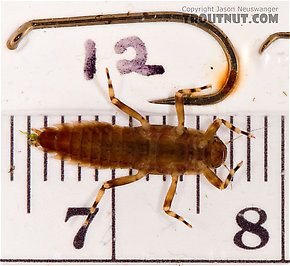 View 9 PicturesI'm pretty sure this is Ephemerella aurivillii. The body is 11mm long, which rules out most other species, and the hind legs seem to be more than 1.5 times longer than the fore legs -- a key characteristic for this species.
View 9 PicturesI'm pretty sure this is Ephemerella aurivillii. The body is 11mm long, which rules out most other species, and the hind legs seem to be more than 1.5 times longer than the fore legs -- a key characteristic for this species.
This specimen isn't in the best of shape, as it's missing all three tails, but it's the only one of its species I captured in this sample.
 View 9 PicturesI'm pretty sure this is Ephemerella aurivillii. The body is 11mm long, which rules out most other species, and the hind legs seem to be more than 1.5 times longer than the fore legs -- a key characteristic for this species.
View 9 PicturesI'm pretty sure this is Ephemerella aurivillii. The body is 11mm long, which rules out most other species, and the hind legs seem to be more than 1.5 times longer than the fore legs -- a key characteristic for this species.This specimen isn't in the best of shape, as it's missing all three tails, but it's the only one of its species I captured in this sample.
Collected May 6, 2007 from Mongaup Creek in New York
Added to Troutnut.com by Troutnut on May 18, 2007
Added to Troutnut.com by Troutnut on May 18, 2007
Eurylophella (Chocolate Duns) Mayfly Nymph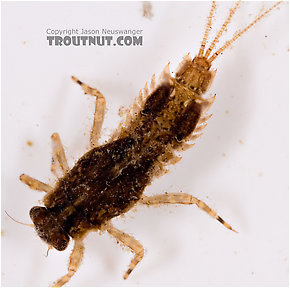 View 8 Pictures
View 8 Pictures
 View 8 Pictures
View 8 PicturesCollected May 6, 2007 from Mongaup Creek in New York
Added to Troutnut.com by Troutnut on May 18, 2007
Added to Troutnut.com by Troutnut on May 18, 2007
Rhyacophila carolina (Green Sedge) Caddisfly Larva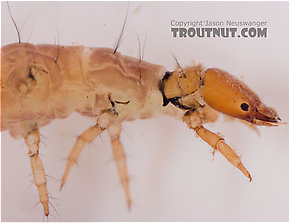 View 8 PicturesThis specimens shows that the name "green rockworm" doesn't quite fit all Rhyacophila larvae, even though it does fit the majority. This is actually the first of their larvae that I've found in a different color. I'm not sure if it's because of the species or because this is a young one, but I have found equally small green larvae, so I'm guessing it's the species.
View 8 PicturesThis specimens shows that the name "green rockworm" doesn't quite fit all Rhyacophila larvae, even though it does fit the majority. This is actually the first of their larvae that I've found in a different color. I'm not sure if it's because of the species or because this is a young one, but I have found equally small green larvae, so I'm guessing it's the species.
 View 8 PicturesThis specimens shows that the name "green rockworm" doesn't quite fit all Rhyacophila larvae, even though it does fit the majority. This is actually the first of their larvae that I've found in a different color. I'm not sure if it's because of the species or because this is a young one, but I have found equally small green larvae, so I'm guessing it's the species.
View 8 PicturesThis specimens shows that the name "green rockworm" doesn't quite fit all Rhyacophila larvae, even though it does fit the majority. This is actually the first of their larvae that I've found in a different color. I'm not sure if it's because of the species or because this is a young one, but I have found equally small green larvae, so I'm guessing it's the species.Collected May 6, 2007 from Mongaup Creek in New York
Added to Troutnut.com by Troutnut on May 18, 2007
Added to Troutnut.com by Troutnut on May 18, 2007
Brachycentridae (Apple Caddis and Grannoms) Caddisfly Pupa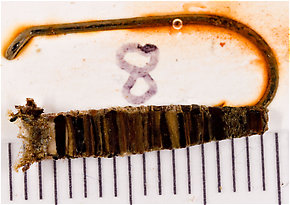 View 9 Pictures
View 9 Pictures
 View 9 Pictures
View 9 PicturesCollected May 6, 2007 from Mongaup Creek in New York
Added to Troutnut.com by Troutnut on May 18, 2007
Added to Troutnut.com by Troutnut on May 18, 2007
Ameletus (Brown Duns) Mayfly Nymph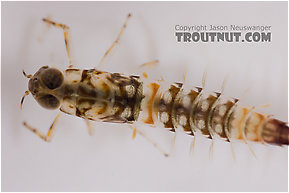 View 7 PicturesI think this is a pretty early instar (Instar: Many invertebrates molt through dozens of progressively larger and better-developed stages as they grow. Each of these stages is known as an instar. Hard-bodied nymphs typically molt through more instars than soft-bodied larvae.) Ameletus nymph. It's certainly a striking one.
View 7 PicturesI think this is a pretty early instar (Instar: Many invertebrates molt through dozens of progressively larger and better-developed stages as they grow. Each of these stages is known as an instar. Hard-bodied nymphs typically molt through more instars than soft-bodied larvae.) Ameletus nymph. It's certainly a striking one.
 View 7 PicturesI think this is a pretty early instar (Instar: Many invertebrates molt through dozens of progressively larger and better-developed stages as they grow. Each of these stages is known as an instar. Hard-bodied nymphs typically molt through more instars than soft-bodied larvae.) Ameletus nymph. It's certainly a striking one.
View 7 PicturesI think this is a pretty early instar (Instar: Many invertebrates molt through dozens of progressively larger and better-developed stages as they grow. Each of these stages is known as an instar. Hard-bodied nymphs typically molt through more instars than soft-bodied larvae.) Ameletus nymph. It's certainly a striking one.Collected May 6, 2007 from Mongaup Creek in New York
Added to Troutnut.com by Troutnut on May 18, 2007
Added to Troutnut.com by Troutnut on May 18, 2007
Start a Discussion of Mongaup Creek:
Top 10 Fly Hatches
Top Gift Shop Designs
Eat mayflies.
Top Insect Specimens
Miscellaneous Sites
Troutnut.com is copyright © 2004-2024 Jason
Neuswanger (email Jason). See my FAQ for information about use of my images.
 privacy policy
privacy policy
